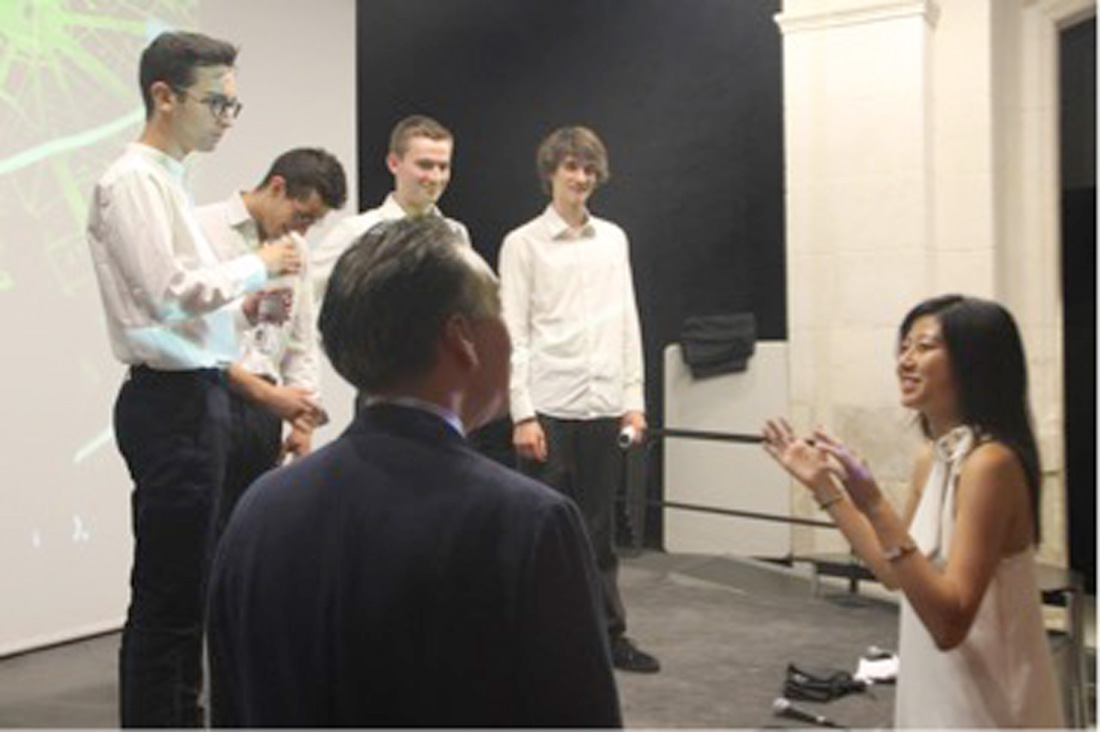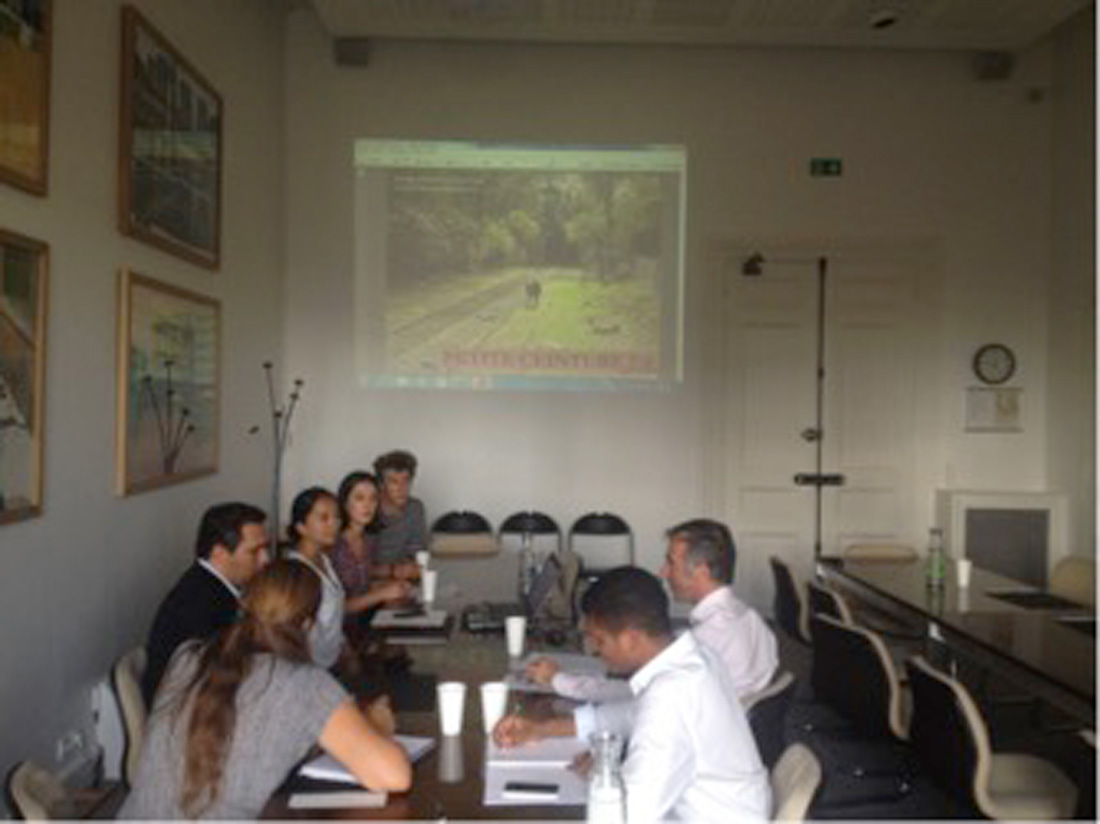Play structures, solar energy, greywater collection, augmented reality, antimicrobial coatings…These are some of the ingredients successive cohorts of students at the Biopolis suggest should be used for a more sustainable Paris.
Can the “city as an organism” framework really ground town-gown initiatives in the local issues the city of Paris has to face? The students and faculty of the Harvard Summer School in Paris certainly believe so.
This summer school is hosted by the CRI[1] and Sciences Po, in partnership with stakeholders involved in the making of the Grand Paris, which was officially launched in January 2016. Such stakeholders include established institutions like the Mairie de Paris, APUR[2], as well as recently launched civic or private initiatives like Arc de l’Innovation .
The format of the school combines actionable project design, biology, and urbanism. As the 2018 edition just launched, it’s a good time for a throwback to the 2017 edition. Fourteen multidisciplinary teams, composed of an even mix of American and European students, presented their proposals at the Hôtel de Ville[3] in July 2017. This concluded eight weeks of immersion for the students, both on the premises of the CRI and in the streets of Paris.
The legacy of the biology/urbanism duo
The Biopolis interdisciplinary town-gown model is carried out by a French-American team, including biologists Robert Lue, Alain Viel and Jessica Liu, pedagogues François Taddei and Yann Algan, as well as urban planner Adam Tanaka. In order to engage students with both principles of biology and project-based planning initiatives, the focus is on ‘fundamental concepts that reveal how living organisms thrive and evolve have equal relevance to the “living organism” of the city’ (Robert Lue). ‘This sort of organismic thinking forces students to conceptualize their projects on a very holistic level: how will their project impact Paris as an urban ecosystem? How can the project leverage preexisting synergies?’ (Adam Tanaka).
As original as it may sound, this bio-urban connection is far from new. It was already the talk of the town for the founders of the Chicago School of urban sociology. The biopolis concept itself was coined by British nineteenth-century planning pioneer and multi-tasker Patrick Geddes (Maaoui 2016). While he excelled at botany, economics, geography, ecology, museography and urban planning, his sociological analyses of Edinburgh’s poor neighborhoods gave birth to a new way of interpreting the city as an organism (Welter 2002). In France, the interdisciplinary duo biology/urbanism also needs to be embedded in a more recent established school of thought on the socio-ecological metabolism of cities (Barles 1995). This echoes a trend that favors initiatives such as those borrowing from the principles of tactical urbanism (Lydon 2015) or smart cities (Picon 2015).
Project-based proposals in search of integration in the city’s fabric
I asked Fanny Lopez, whom I have worked in the past on similar topics, to evaluate this initiative. Fanny is associate professor at the École d’architecture de la ville et des territoires in Marne-la-Vallée Université Paris-Est. She works on energy autonomy and the connections between planning and energy infrastructures including micro grids and the spatial impact of distributed energy.
‘Students should be encouraged to use the central nervous system or DNA structure to critically think about a city. A summer school like this one has all its place in the Parisian arena, and it has the delicate task not to drift into the flashy formalism à la Vincent Caillebaut‘.
Last student-faculty meeting prior to the presentations at the Hôtel de Ville in July 2017.
When it comes to leveraging local resources, whether by connecting with local stakeholders, exploring the potentialities of existing infrastructure or referring to existing local policies, results are mixed. Lopez briefly discusses the feasibility of two selected projects from the summer 2017 edition. The first one, “Jardin Ouvert”, proposes ways to improve green wall initiatives along the banks of the Seine. This project is clearly in tune with the times.
‘It can work on inserting itself in the city’s green ambitions for the horizon of 2020, “Végétalisons Paris”, materialized by the quantitative goal of reaching 100 hectares of green roofs, changes in the PLU (Plan Local d’Urbanisme) in 2009, or the creation of greening permits for private initiatives. In this sense, a strength in this proposal is how it focuses on central districts, which in the end make up only 27% of city surface, but are much denser and in need of such greening initiatives.
Yet, there needs to be more care given to the technicalities of implementation. What is the extent to which Seine water can actually be reused? A Rainwater Zoning was implemented in 2013 to regulate rainwater reuse. The proposal should refer to this regulatory precedent. Besides, if one thinks about it, since the greening initiative was officially launched by the city, only 209 out of 1,500 proposals submitted were granted a permit. This has to do with how important metrics like financing or long-term maintenance matter, to the point where the environmental public agency ADEME[4] lists available funding sources for prospective applicants. Last, in the spirit of town-gown partnerships, they could strongly benefit from getting involved with the school Agro Paris Tech, which turned 600 m2 of its campus infrastructure into a greening laboratory’.
She finds the second project, titled “Greenspired”, which proposes a combination of urban greening and advertising to be less engaging. Lopez argues that students should be wary of how dissonant this might sound for French environmental politics.
‘Critics might call this a greenwashing maneuver. In reframing the elements of the proposal, the message can be less about using nature as a medium for commercial purposes. Only recently, the city of Nantes was the scene of a strong opposition against the use of sidewalks for publicity – any proposal of that nature must take into account such precedents. Instead of risking visual pollution, going for the good old ivy façade here might prove almost equally efficient, provided the right financing tools are mobilized. And if the reference to the list of 169 United Nations Sustainable Goals is completely called for, student projects would benefit from availing themselves from more locally grounded policies like the Grenelle of 2007, amended in 2010 and other policies like SRCAE’.
Taking the biological metaphor up a notch: grounding the city as an organism
So, as successive cohorts of students tackle “the city as organism” metaphor, the question that still remains is where the city of Paris, and its shifting environmental politics, fit into this picture. While the first edition of the summer school involved discussions with approximately ten local expert organizations, two years later, the number doubled. Such networks might give some student teams the opportunity to work toward the actual implementation of their ideas. For instance, three student projects were selected to enter into the Paris Talents 2024 competition, an innovation competition organized in the run-up to the Olympic games in 2017.
2015 edition of students during a meeting with city officials at Hôtel de Ville.
The evolution of the Biopolis initiative over the span of three years is worthy of a special note. Yet, it still needs to focus on a few additional steps in order to be a long-lasting, more integrated city powerhouse concept.
At the local level, it means navigating the controversies that orient local Parisian environmental politics. Mayor Hidalgo’s ambitions keep being curbed by strong NIMBY coalitions. Last February, a court overruled her decision to close access to a portion of the banks of the Seine to cars, as one of her earliest signature anti-pollution measures passed in 2016. The fact that the closing of 3 kilometers of road triggered an upheaval as big as a lawsuit from car users, five departments, the île-de-France region and over a hundred local municipalities, should be carefully taken into account to qualify the scope of some of the boldest innovative student proposals for Paris’ sustainable future. For these steps to unfold, a lot relies on the transformations of the planning arena brought by the current mayoral administration, as well as the newborn Grand Paris governance structure. Thus far, they are showing their ambition to be a fertile ground for innovative sustainable initiatives in the city. This might represent a timely chance.
At the global level, it means taking more advantage of the ambition to make Paris the flagship of sustainability. Think COP21 and the Paris agreement, or President Macron’s “Make Our Planet Great Again”, which can be the most fertile ground for such initiatives. Many citizen-led projects have been launched over the past few years, and many municipal plans have updated their environmental strategies to reflect a bottom-up translation of the Paris agreement. The same Paris agreement from which President Trump withdrew last June. This probably makes French-American academic projects like this one even more so timely, in a context where the reality of a global environmental crisis is vivid. Such transatlantic collaborations might prove useful in shaping the future of green political actions, even if they are modest, small-scale student projects.













